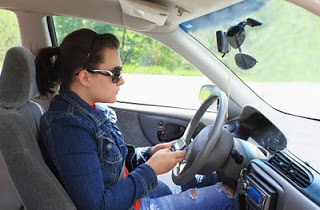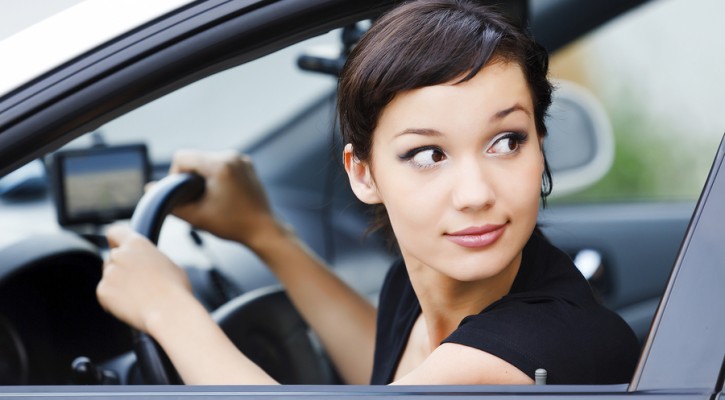Tag Archive: driver safety

Reaching for Items in Your Vehicle and Distracted Driving
October 26, 2009
The hazard drivers create when they text or talk on cell phones has received considerable attention in the popular press recently. However, a more common distracted driving hazard is reaching for an item in the vehicle. Though cell phone use while driving is a significant problem, National Highway Traffic Safety Administration (NHTSA) studies indicate that it is a relatively small proportion of the distracted driving issue.
Driving distractions occur anytime something takes your eyes off the road, your hands off the steering wheel, or your mental attention from the task. Some distractions involve two or even all three of these. When you look for a particular song on a CD or MP3 player, your eyes turn from the road ahead, you remove at least one hand from the steering wheel, and you are temporarily preoccupied by the task of searching for the song you want to hear.
Other “reaching” distractions include:
- Eating
- Smoking
- Manipulating the controls of the aforementioned stereo, an in-vehicle navigation system or the climate control system
- Reaching for a fallen object
NHTSA estimates that drivers participate in potentially distracting activities about 30% of the time their vehicles are moving. Distraction may result in:
- loss of vehicle control
- unintended speed changes
- leaving the lane of travel
- missed opportunities to respond to changes in the driving scene
Though a motor vehicle crash caused by a driver reaching for something in the vehicle is not easily proved unless the driver admits to it, most drivers are aware of having driven while distracted by reaching for something in the vehicle.
“Reaching for something” does not have to mean reaching for an inanimate object. When they reach out to soothe, protect or discipline their children and pets, drivers’ attention is removed from the driving scene. Driving requires all your concentration, and parents should teach their children this and reinforce the lesson when necessary. Children should be fastened into appropriate safety restraint systems. While distractions aren’t good for you as a driver, they are great for children as passengers; DVDs, books, games, and small toys can keep them occupied until you reach your destination. If your children need attention, find a safe place to pull off the roadway. Your furry friend can travel safely in a pet carrier or safety harness. Never let your pet ride in your lap or roam around the vehicle while you drive.
Other ways to manage distractions include adjusting all of the vehicle’s controls before you start to drive and during stops at traffic lights, asking passengers to assist you when you need to get something inside your vehicle, and taking breaks to eat, drink and smoke.
Learning how to manage the distraction of reaching for things in your vehicle is a daunting task because it occurs so frequently. But doing so will allow you to keep you, your passengers, and other road users safe when you’re behind the wheel.
Driver Education: Driving with a Cold or the Flu
October 5, 2009
With cold and flu season here, many drivers are hurrying to drug stores and pharmacies for tissues, hand sanitizer, and over-the-counter medications to relieve symptoms such as sneezing, coughing, fever, and body aches. Unfortunately, alleviating cold and flu symptoms won’t necessarily make them safer drivers.
Colds are characterized by sore throat, sneezing and runny nose, and coughing.
Although many people have little to no fever with colds, these effects can be debilitating. Aside from the distraction these symptoms cause, drivers are often irritable due to their degree of discomfort and drowsy because the symptoms make it difficult to sleep well. This collection of problems can mean that these drivers take chances they wouldn’t ordinarily take, such as turning left in front of oncoming traffic or running red traffic lights, in an effort to get home quickly.
Flu symptoms commonly include coughing and body aches, often with a high fever and chills. In addition to feeling ill-tempered and sleepy, these drivers may also suffer from disorientation and dizziness. Driving effects could include slower reaction time, poor coordination, and impaired judgment.
In an effort to continue their normal activities, some drivers choose to take over-the-counter medications to ease their cold or flu symptoms. However, these medications do not typically eliminate symptoms. They also wear off quickly and can have side effects that compromise the user’s ability to drive safely, such as:
- Dizziness or lightheadedness
- Loss of muscle control and motor coordination
- Increased reaction time
- Jittery feelings and nervousness
- Drowsiness
It’s best to stay off the road when you have a cold or the flu. Seek support from family and friends by asking for a ride to the doctor’s office if you need to go and arranging carpools for your children; you can repay these favors when you’re feeling better. Getting plenty of rest is the best way for you to recover from the cold or flu quickly so you can safely get back on the road.

Scooter Safety for Riders and Other Motorists
September 23, 2009
They are popping up everywhere; on college campuses, in urban areas, neighborhoods, and in retirement communities. Whether it’s for fun, cost savings, environmental considerations or out of practicality, scooters and mopeds are growing in use and popularity. While these scooters are zipping about, everyone on the roadways needs to take extra precautions with mopeds and scooters in the driving environment.
Motorist should keep in mind that it is difficult to judge how fast a scooter or moped is traveling.
They are also smaller, difficult to see, and appear farther away than they really are. Maintain your scan of the road to ensure you are aware of their location and continually check your blind spots. Always manage your space cushion and continue to adjust with the flow of traffic as you never know when a scooter will need to make an evasive maneuver. Increase your following distance to a minimum of four seconds in ideal weather conditions and 5 seconds in inclement weather and at night. Even wind can affect the stability and direction a scooter travels. Dim your high beams at night when approaching a moped or scooter as they are more susceptible to their blinding affect.
If traveling by a moped or scooter take extra precautions. Check to make sure you have met all the legal licensing, registration and equipment requirements for your local and state area before travelling on the road. Some vehicles with a motor capacity of 50cc are classified as a motorcycle and require a Motorcycle Safety Course. Know before you go. It is helpful to take a motorcycle practice test prior to taking your safety course.
Make sure your equipment is working and in excellent condition. Poor tire tread, improper inflation, worn brakes and equipment malfunctions can be huge problems on the road. Evaluate your load, cargo and whether to have a passenger as they directly affect your vehicles stability, performance and ability to maneuver.
Wear clothing that will give the greatest protection in a fall. Choose clothing that is light, bright and snug. If traveling during dawn, dusk or nighttime hours, add reflective tape to clothing for increased visibility. Consider boots, a jacket, long pants and gloves. Protect your eyes with safety glasses or goggles.
Head injury is a leading cause of death and disability in moped and motor scooter crashes. Wearing a helmet is the single most effective means to prevent head injury. Ensure that your helmet fits properly and is Department of Transportation (DOT) approved. Helmet use is mandatory in most states.
On the roadway, give yourself plenty of space from all sides. Travel in the center of the lane and if riding with other motor scooters travel in a staggered formation. Always drive defensively; looking for an escape route, should you need to make an evasive maneuver. Keep a three to five second visual scan and be sure to check your blind spots. Turning your headlights on during the day can improve your ability to be seen by pedestrians and other vehicles. When riding, your hands should be on the handlebars and your feet on the floorboards. Watch out for road hazards and defects. Signal well in advance, and consider using hand signals for extra safety.
Be extra cautious when approaching driveways, parking lots, and intersections. Reduce your speed for lower visibility conditions such as dawn, dusk, nighttime and poor weather. Avoid having sudden starts, braking and quick turns as they cause instability.
When reaching your destination, park on level ground, turn off the engine and if you have any passengers let them get off the scooter first.
With awareness and a few extra precautions, mopeds and scooters can operate safely on our roads.

The Importance of a Safe Driving Attitude
May 15, 2009
One important aspect of driver training is the development of a safe driving attitude. The reason a safe driving attitude is so important is because you will make many choices as you drive, and your driving choices have consequences. There are many benefits to a safe driving attitude, including:
- limiting stress while on the road
- saving you money on tickets and increased insurance costs
- helping you keep your driver license
- reducing your chances of being in a crash
To have a safe driving attitude, you must have control of your emotions and behavior, practice defensive driving techniques, and accept responsibility for all of your driving decisions.
Emotion is a word used to identify feelings such as anger, fear and joy. If you allow them to, emotions can change the way you assess risk and make driving decisions. When strong emotions such as anger affect you, your ability to make wise decisions may be reduced, increasing your chances of making a mistake. You may be so preoccupied with your anger that you misjudge the risks involved or don’t even notice important events in a particular driving situation.
Always be aware of your state of mind. Look at yourself objectively and decide if you really have the focus and alertness you need to safely use a motor vehicle. If you have any doubt, wait. Give yourself time to calm down and concentrate on safe driving. Learn more about how to avoid a road range incident.
You can expect some emotional stress in your everyday driving. Learning to manage it is important for your safety and the safety of others:
- If you are angry and excited, take a short walk, write your feelings down or talk to a friend before you get behind the wheel.
- No matter what is going on in your life, when you get behind the wheel, make a decision that until you arrive safely at your destination, you will focus on driving.
- Always allow plenty of time to get to your destination so you won’t get impatient with red lights or heavy traffic.
- Realize that many aspects of driving, such as heavy traffic and the actions of other drivers, are beyond your control. Stay calm when faced with stressful road conditions.
Part of having a safe driving attitude is consistently practicing defensive driving techniques:
- Make sure your vehicle is properly maintained
- Wear your safety belt and make sure your passengers do the same
- Choose a speed appropriate for conditions
- Make sure you have a space cushion all around your vehicle whenever possible
- Be alert and aware of the actions of all other road users, including motorcyclists, bicyclists, and pedestrians
- Watch the road ahead, behind and on both sides of your vehicle
- Anticipate problems early and select the best course of action in case the worst happens
- Give other drivers the benefit of the doubt when they make mistakes
Accepting responsibility for our decisions is an important part of becoming an adult. Willingness to do so demonstrates maturity and trustworthiness. When you drive, you must make sure you are willing to accept responsibility for all of your driving decisions. Other drivers cannot make you behave in one way or another; your reactions to their behavior are within your control. You must discipline yourself to put safety first no matter what any other driver does.
Developing a safe driving attitude is an important component of driver training; doing so from the beginning of your driving career will help keep you and others out of harm’s way on the road.
Bicycle Safety Tips while on Spring Break
April 1, 2009
Beach towns are a popular spring break vacation destination, and often a bicycle is the easiest form of travel in these small, often-congested areas. But bicyclists are vulnerable to other road users, especially motor vehicles. In fact, the first automobile crash in the United States occurred in New York City in 1896, when a motor vehicle collided with a bicycle rider (Famous First Facts, by Joseph Kane).
Tips for Bicyclists
- Bicyclists must obey all traffic controls and signals.
- Be sure to comply with helmet laws in the state where you are riding. Bicycle helmets are recommended for all ages.
- Watch for pedestrians as well as motor vehicles.
- If you are allowed to ride on the sidewalk, yield the right-of-way to pedestrians and give an audible signal before passing.
- Keep at least one hand on the handlebars.
- On the roadway, check behind you before changing lanes. Signal your intent to turn to other vehicle operators by pointing in the direction you are going to turn.
- Do not ride two abreast when this will impede the flow of traffic.
- Do not wear headphones or any other listening device except a hearing aid while bicycling.
Tips for Motorists
- Give bicycles extra space whenever possible. Some riders may not be able to control their bicycles well and may suddenly get in your path. Be sure to give extra space to young riders, riders who seem distracted, riders who may have been drinking and older riders.
- As you start to pass, approach slowly and try not to frighten the rider. Be aware of the possible path the bicyclist may take. Riders may swerve for hazards you are not aware of, such as potholes, puddles, and storm drains.
- Always start your pass well behind the bicycle. You should have at least a half-lane of space between your vehicle and the bicyclist. If you do not have this much space, wait for a gap in oncoming traffic and then pass.
- Before you move over to pass, signal to traffic behind you to let them know that you are changing lanes. You may want to warn the cyclist by tapping your horn.
- At night, use your low beam headlights when traveling near bicyclists. Avoid shining your high beam headlights into riders’ eyes.
- When parallel parking, check for bicycles before opening the driver’s side door.
Bicycling is a fun, efficient form of transportation. Put safety first for a better spring break.
